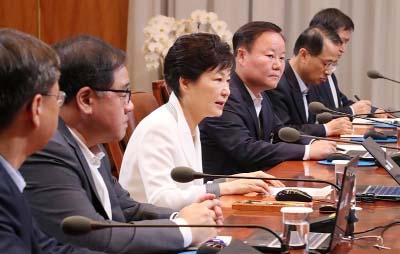
Reuters, Seoul :
South Korean President Park Geun-hye said on Thursday the move to deploy a THAAD missile defense system was “inevitable” because of a growing threat from North Korea and that division in the South over its deployment is what Pyongyang seeks.
North Korea’s launch of three ballistic missiles on Tuesday was the latest evidence that the anti-missile system is needed, Park said at a National Security Council meeting.
This month’s announcement by South Korea and the United States to deploy a Terminal High Altitude Area Defence (THAAD) unit with the U.S. military in a rural melon-farming county in the South triggered loud protests from residents worried about possible negative health and environmental impacts.
“If we continue to be divisive and social confusion grows about a decision we had no choice but to make to protect the country and the lives of our people, it would be exactly where North Korea wants us to go,” Park said, according to her office.
North Korea said on Wednesday it had conducted a ballistic missile test that simulated preemptive strikes against South Korean ports and airfields used by the U.S. military, likely referring to the three missiles fired on Tuesday.
The missiles flew between 500 kms and 600 kms (300-360 miles) into the sea off its east coast and could have hit anywhere in South Korea if the North intended, the South’s military said.
Many residents of Seongju, about 200 kms (120 miles) from the capital Seoul, joined by opposition members of parliament and civic groups, have demanded the government scrap the decision to site the THAAD battery there.
Some residents bearing South Korean flags and anti-THAAD banners held a rally in central Seoul on Thursday to demonstrate against the decision. Roughly 2,000 people joined the rally, according to police and organizers, including the governor of Seongju who shaved his head in protest.
That follows a raucous standoff last week between residents and the country’s prime minister, who was pelted with eggs and plastic bottles and trapped inside a bus for several hours when he visited the county to explain the THAAD decision. Some residents blamed outside leftist activists for the incident.
Park said North Korea could stage an act of aggression at any time, including possibly a fifth nuclear test or cyber attack against the networks of national and financial institutions.
The North has also increased military equipment near the land and sea border separating the countries, she told the security meeting.
The two Koreas remain technically at war under a truce that ended fighting in the 1950-53 Korean War.
Tension on the Korean peninsula has been high since North Korea conducted its fourth nuclear test in January and followed that with a satellite launch and a string of test launches of various missiles.
South Korean President Park Geun-hye said on Thursday the move to deploy a THAAD missile defense system was “inevitable” because of a growing threat from North Korea and that division in the South over its deployment is what Pyongyang seeks.
North Korea’s launch of three ballistic missiles on Tuesday was the latest evidence that the anti-missile system is needed, Park said at a National Security Council meeting.
This month’s announcement by South Korea and the United States to deploy a Terminal High Altitude Area Defence (THAAD) unit with the U.S. military in a rural melon-farming county in the South triggered loud protests from residents worried about possible negative health and environmental impacts.
“If we continue to be divisive and social confusion grows about a decision we had no choice but to make to protect the country and the lives of our people, it would be exactly where North Korea wants us to go,” Park said, according to her office.
North Korea said on Wednesday it had conducted a ballistic missile test that simulated preemptive strikes against South Korean ports and airfields used by the U.S. military, likely referring to the three missiles fired on Tuesday.
The missiles flew between 500 kms and 600 kms (300-360 miles) into the sea off its east coast and could have hit anywhere in South Korea if the North intended, the South’s military said.
Many residents of Seongju, about 200 kms (120 miles) from the capital Seoul, joined by opposition members of parliament and civic groups, have demanded the government scrap the decision to site the THAAD battery there.
Some residents bearing South Korean flags and anti-THAAD banners held a rally in central Seoul on Thursday to demonstrate against the decision. Roughly 2,000 people joined the rally, according to police and organizers, including the governor of Seongju who shaved his head in protest.
That follows a raucous standoff last week between residents and the country’s prime minister, who was pelted with eggs and plastic bottles and trapped inside a bus for several hours when he visited the county to explain the THAAD decision. Some residents blamed outside leftist activists for the incident.
Park said North Korea could stage an act of aggression at any time, including possibly a fifth nuclear test or cyber attack against the networks of national and financial institutions.
The North has also increased military equipment near the land and sea border separating the countries, she told the security meeting.
The two Koreas remain technically at war under a truce that ended fighting in the 1950-53 Korean War.
Tension on the Korean peninsula has been high since North Korea conducted its fourth nuclear test in January and followed that with a satellite launch and a string of test launches of various missiles.

